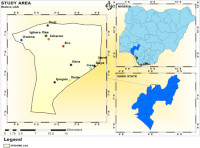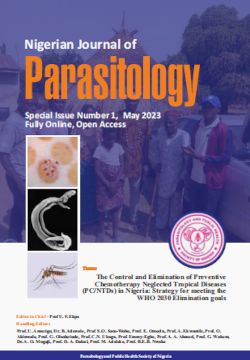Prevalence of Antimalaria-Drug-Resistant-Plasmodium-falciparum Mutant Genes in Out-Patients from a Malaria Endemic Region in Southwest, Nigeria
https://dx.doi.org/10.4314/njpar.v44i1.3
Keywords:
Ifedore LGA, Prevalence, Malaria, Pfcrt and Pfmdr1Abstract
The research identified, ipso facto, Pfcrt gene SNP at codons 72&76 and Pfmdr1 gene SNPs at codons 86 &184 and 1034,1042 &1246 from malaria patients in Ifedore Local Government Area (LGA) in Ondo State, Nigeria. Thick blood film microscopy was used to examine blood samples from 2,063 febrile malaria patients within the study area. Four hundred positive samples were used to make Dry Blood Spots (DBS) on Whatman No.3 paper. The parasite DNA was extracted from the DBS samples using spin column-based DNA purification kit. Identification and genotyping of the Pfcrt and Pfmdr1 mutant genes of the parasite were done using Nested PCR method. Molecular analysis of the 400 positive samples yielded 352 positive results after testing with various plasmodia markers with only Plasmodium falciparum detected in the study area. Results obtained from genotyping the mutant genes showed that of all the 352 P. falciparum isolates examined, Pfmdr1 SNP at codons 86&184 recorded the highest prevalence (11.08%), followed by Pfmdr1 SNP at codon 1034,1042&1246 (7.95%) while Pfcrt SNP at codon 72&76 recorded the lowest prevalence (3.41%). A prevalence of 19.32% coexistence of the three SNPs of the mutant genes was observed among the study population (p<0.05). The existence of the Pfcrt and Pfmdr1 mutant genes suggests resistance of P. falciparum to most malaria drugs used in the treatment of malaria in the study area. Therefore, it is important to monitor resistance to treatment regimens and therapeutics to aid the management of malaria in endemic areas.
References
Ndung’u, L., Langat, B., Magiri, E., Ng’ang’a, J., Irungu, B., Nzila, A. and Kiboi, D. (2017). Amodiaquine Resistance in Plasmodium berghei is associated with PbCRT His95Pro mutation, loss of chloroquine, artemisinin and primaquine sensitivity, and high transcript levels of key
transporters. Wellcome Open Research 2: 44. https://doi.org/10.12688/wellcomeopenres. 11768.1.
World Health Organization (2018). World malaria report 2018. Geneva: World Health Organization. https://www.who.int/docs/defaultsource/gho-documents/world-healthstatistic-reports/6-june-18108-worldhealth-statistics-2018.pdf.
Ileke, K. D., Obimakinde, E. T., Anthony, C. M. and Olayinka-Olagunju, J. O. (2019). Efficacy of Tithonia diversifolia and Momordica charantia Leaves Extracts against Malaria Vector, Anopheles gambiae Gile (Diptera: Culicidae). International Journal of Tropical Disease & Health 36 (2):
– 8 , https://doi.org/10.9734/ijtdh/2019/v36i230 139.
Caraballo, H. (2014). Emergency Department Management of MosquitoBorne Illness: Malaria, Dengue, and West Nile Virus. Emergency Medicine Practice 16 (5): 1-23.
World Health Organization (2014). World Health Organisation| Immunization. In Health topic. http://www.who.int/topics/immunization/en
/.
World Health Organization (2020). World malaria report 2020. World Health Organisation World malaria report. https://www.who.int/publications/i/item/9789240015791.
European Centre for Disease Prevention and Control (ECDC) (2021). Prevention and control measures for malaria. https://www.ecdc.europa.eu/en/malaria/prevention-and-control.
World Health Organization (2015). Guidelines for the treatment of malaria. Geneva: World Health Organization. https://apps.who.int/iris/handle/10665/1624 41.
Sowunmi, A., Akano, K., Ntadom, G., Ayede,A. I., Ibironke, F. O.,Aderoyeje, T., Adewoye, E. O., Fatunmbi, B., Oguche, S., Okafor, H. U., Watila, I., Meremikwu, M., Agomo, P., Ogala, W., Agomo, C. and Folarin, O. A. (2017). Therapeutic efficacy and effects of artemisinin-based
combination treatments on uncomplicated Plasmodium falciparum malaria-associated anaemia in Nigerian children during seven years of adoption as first-line treatments. Infectious Diseases of Poverty 6(30): 1–20, https://doi.org/10.1186/s40249-016-0217-7.
Mishra, N., Prajapati, S. K., Kaitholia, K., Bharti, R. S., Srivastava, B., Phookan, S., Anvikar, A. R., Dev, V., Sonal, G. S., Dhariwal, A. C., White, N. J. and Valecha, N. (2015). Surveillance of Artemisinin Resistance in Plasmodium falciparum in India Using the kelch-13 Molecular Marker.
Antimicrobial Agents and Chemotherapy 59(5): 2548 – 2553, https://doi.org/10.1128/AAC.04632-14.
Fidock, D. A., Nomura, T., Talley, A. K., Cooper, R. A., Dzekunov, S. M., Ferdig, M. T., Ursos, L. M. B., Bir Singh Sidhu,A., Naudé, B., Deitsch, K. W., Su, X. Z., Wootton, J. C., Roepe, P. D. and Wellems, T. E. (2000). Mutations in the P. falciparum digestive vacuole transmembrane protein
Pfcrt and evidence for their role in chloroquine resistance. Molecular Cell 6(4): 861–871, https://doi.org/10.1016/S1097- 2765(05)00077-8.
Djimdé, A., Doumbo, O. K, Cortese, J. F., Kayentao, K., Doumbo, S., Diourté, Y., Dicko, A., Su, X. Z., Nomura, T., Fidock, D. A., Wellems, T. E., Plowe, C. V. and Coulibaly, D. (2001). A Molecular Marker for Chloroquine-Resistant falciparum Malaria. New England Journal of Medcine
: 257–263.
Ecker, A., Lehane, A. M., Clain, J. and Fidock, D. A. (2012). Pfcrt and its Role in Antimalarial Drug Resistance. Trends in Parasitology 28(11): 504–514.
I d o w u , A . O . , O y i b o , W. A . , Bhattacharyya, S., Khubbar, M., Mendie, U. E., Bumah, V. V., Black, C., Igietseme, J. and Azenabor, A. A. (2019). Rare mutations in Pfmdr1 gene of Plasmodium falciparum detected in clinical isolates from patients treated with anti-malarial drug in
Nigeria. Malaria Journal 18(319): 1-5, https://doi.org/10.1186/s12936-019-2947-z.
Holmgren, G., Gil, J. P., Ferreira, P. M., Veiga, M. I., Obonyo, C. O. and Björkman, A. (2006). Amodiaquine Resistant Plasmodium falciparum malaria in vivo is Associated with Selection of Pfcrt 76T and Pfmdr1 86Y. Infection, Genetics and Evolution 6(4) :309 – 314, https://doi.org/10.1016/j.meegid.2005.09.001.
Venkatesan, M., Gadalla, N. B., Stepniewska, K., Dahal, P., Nsanzabana, C., Moriera, C., Price, R. N., Ma˚rtensson, A., Rosenthal, P. J., Dorsey, G., Sutherland, C. J., Guérin, P., Davis, T. M. E., Ménard, D., Adam, I., Ademowo, G., Arze, C., Baliraine, F. N., Berens-Riha, N., Björkman, A., Borrmann, S., Checchi, F., Desai, M., Dhorda, M., Djimdé, A. A., ElSayed, B. B., Eshetu, T., Eyase, F., Falade, C., Faucher, J. F., Fröberg, G., Grivoyannis, A., Hamour, S., Houzé, S., Johnson, J., Kamugisha, E., Kariuki, S., Kiechel, J. R., Kironde, F., Kofoed, P. E., LeBras, J., Malmberg, M., Mwai, L., Ngasala, B., Nosten, F., Nsobya, S. L., Nzila, A., Oguike, M., Otienoburu, S. D., Ogutu, B., Ouédraogo, J. B., Piola, P., Rombo, L., Schramm, B., Somé, A. F., Thwing, J., Ursing, J., Wong, R. P.M., Zeynudin, A., Zongo, I., Plowe, C. V. and Sibley, C. H. (2014). Polymorphisms in
Plasmodium falciparum chloroquine resistance transporter and multidrug resistance 1 genes: Parasite risk factors that affect treatment outcomes for P. falciparum malaria after artemether-lumefantrine and artesunate-amodiaquine. American Journal of Tropical Medicine and Hygiene 91(4): 218, https://doi.org/10.4269/ajtmh.14-0031.
Salako, L.A., Sowunmi,A. and Walker, O. (1990). Evaluation of the clinical efficacy and safety of halofantrin, in IFN-a is said to have antiviral activities, its elevated concentration might have an effect on the falciparum malaria in Ibadan, Nigeria. Transaction of Royal Society of Tropical
Medicine and Hygiene 84: 644–647.
Umotong, A. B., Ezedinachi, E. N., Okerengwo,A.A., Usanga, E.A., Udo, J. J. and Williams, A. (1991). correlation between in-vivo and in-vitro response of chloroquine resistance Plasmodium falciparum in Calabar, South-Eastern Nigeria. Acta Tropica 49: 119–125.
Sowunmi, A. and Salako, L. A. (1992). Evaluation of the relative efficacy of various antimalarial drugs in Nigerian children under 5 years of age suffering from acute uncomplicated falciparum malaria. America Tropical Medical Parasitology 86: 1–8.
Okungbowa, M. A. O. and Mordi, R. M. (2013). Prevalence and Distribution of Malaria, Pfcrt, and pfmdr 1 genes in Benin Metropolis, Edo State, Nigeria. Nigerian Journal of Parasitoogy 34(2): 47–54.

Downloads
Published
How to Cite
Issue
Section
License
Copyright (c) 2023 Nigerian Journal of Parasitology

This work is licensed under a Creative Commons Attribution-NonCommercial-NoDerivatives 4.0 International License.




